2018 MERCEDES-BENZ CLA warning
[x] Cancel search: warningPage 274 of 326
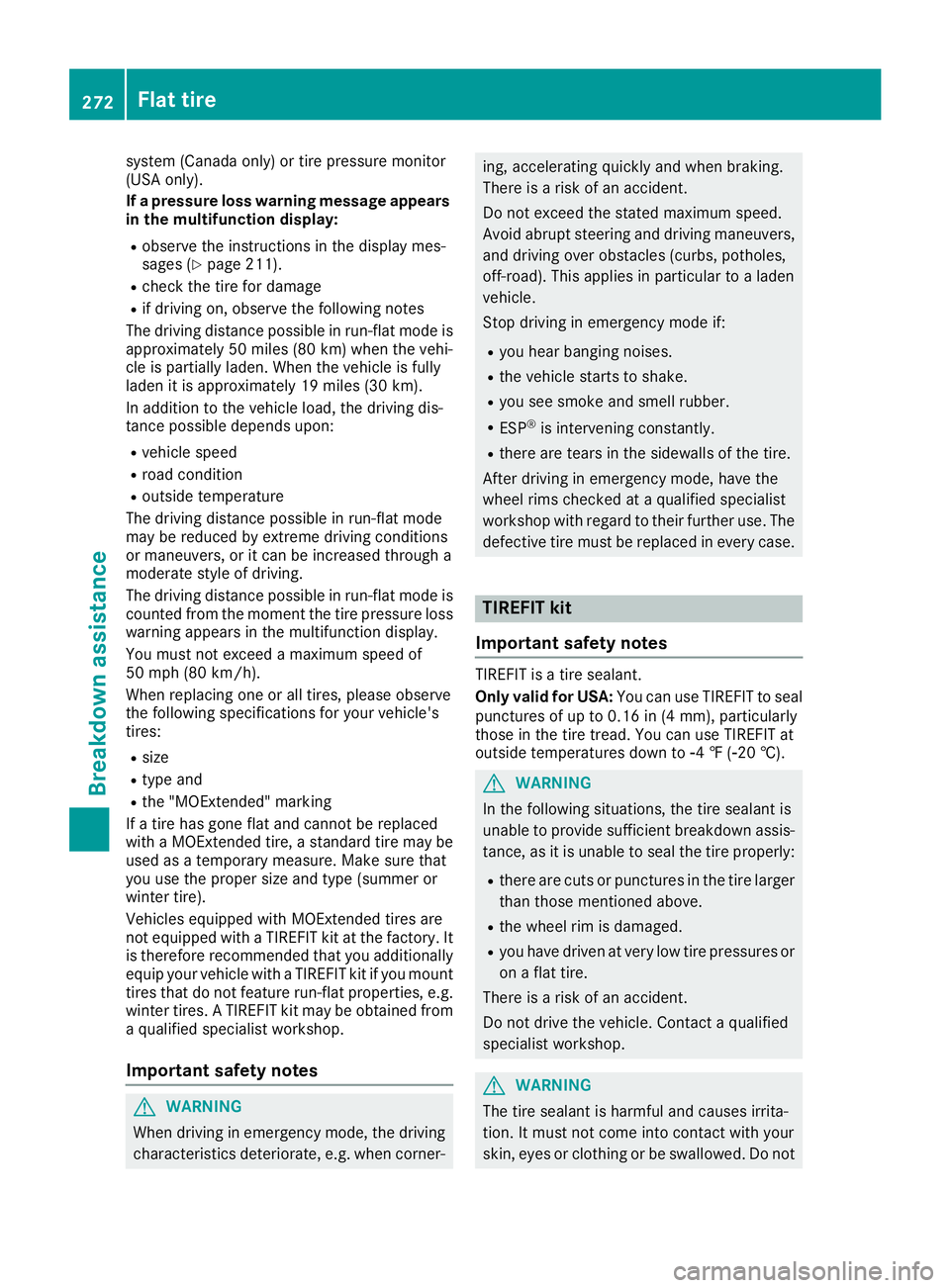
system (Canad ao nly) or tire pressure monitor
(USA only).
If ap ressure loss warning message appears
in the multifunction display: R
observe the instructions in the displa ym es-
sages ( Y
page 211).R
check the tire for damage R
if driving on, observe the following notes
The driving distance possible in run-flat mode is
approximately 50 miles (80 km) when the vehi-
cle is partiall yl aden. When the vehicle is fully
laden it is approximately 19 miles (30 km).
In addition to the vehicle load, the driving dis-
tance possible depends upon: R
vehicle speed R
road condition R
outside temperature
The driving distance possible in run-flat mode
may be reduced by extreme driving conditions
or maneuvers, or it can be increased through a
moderate style of driving.
The driving distance possible in run-flat mode is
counted from the moment the tire pressure loss
warning appears in the multifunction display.
You must not exceed am aximum speed of
50 mph (80 km/h).
When replacing one or all tires, please observe
the following specifications for your vehicle's
tires: R
size R
type and R
the "MOExtended" marking
If at ire has gone flat and cannot be replaced
with aM OExtended tire, as tandard tire may be
used as at emporary measure. Make sure that
you use the proper size and type (summer or
winter tire).
Vehicles equipped with MOExtended tires are
not equipped with aT IREFIT kit at the factory. It
is therefore recommended that you additionally
equip your vehicle with aT IREFIT kit if you mount
tires that do not feature run-flat properties, e.g.
winter tires. AT IREFIT kit may be obtained from
aq ualified specialist workshop.
Important safety notes
G WARNING
When driving in emergency mode, the driving
characteristics deteriorate, e.g. when corner- ing, accelerating quickly and when braking.
There is ar isk of an accident.
Do not exceed the stated maximum speed.
Avoid abrupt steering and driving maneuvers,
and driving over obstacles (curbs, potholes,
off-road). This applies in particular to al aden
vehicle.
Stop driving in emergency mode if: R
you hear banging noises. R
the vehicle starts to shake. R
you see smoke and smell rubber. R
ESP ®
is intervenin gc onstantly.R
there are tears in the sidewalls of the tire.
After driving in emergency mode, have the
wheel rims checked at aq ualified specialist
workshop with regard to their further use. The
defective tire must be replaced in every case.
TIREFIT kit
Important safety notes TIREFIT is at ire sealant.
Only valid for USA: You can use TIREFIT to seal
punctures of up to 0.16 in (4 mm), particularly
those in the tire tread. You can use TIREFIT at
outside temperatures down to �
Page 277 of 326
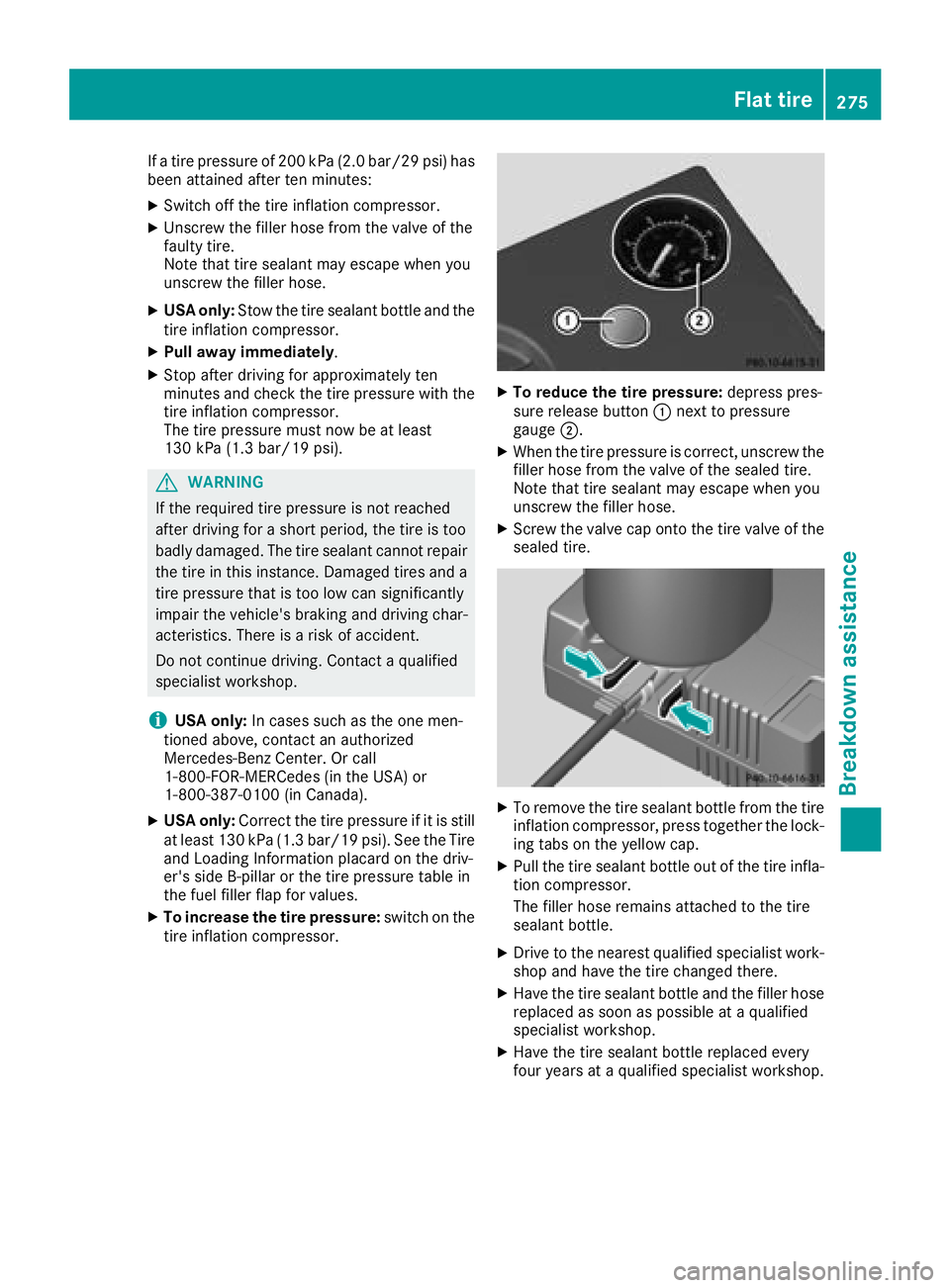
If at ire pressure of 200 kPa (2.0 bar/29 psi) has
been attained after ten minutes: X
Switch off the tire inflation compressor. X
Unscrew the fille rh ose from the valve of the
faulty tire.
Note that tire sealant may escape when you
unscrew the fille rh ose.X
USA only: Stow the tire sealant bottle and the
tire inflation compressor. X
Pull away immediately .X
Stop after driving for approximately ten
minutes and check the tire pressure with the
tire inflation compressor.
The tire pressure must now be at least
130 kPa (1.3 bar/19 psi).
G WARNING
If the required tire pressure is not reached
after driving for as hort period ,t he tire is too
badl yd amaged. The tire sealant cannot repair
the tire in this instance. Damaged tires and a
tire pressure that is too low can significantly
impair the vehicle's braking and driving char-
acteristics. There is ar isk of accident.
Do not continue driving. Contact aq ualified
specialist workshop.
i USA only: In cases such as the one men-
tioned above ,c ontact an authorized
Mercedes-Benz Center. Or call
1-800-FOR-MERCedes (in the USA) or
1-800-387-0100 (in Canada). X
USA only: Correct the tire pressure if it is still
at least 130 kPa (1.3 bar/19 psi). See the Tire
and Loading Information placard on the driv-
er's side B-pilla rort he tire pressure table in
the fuel fille rf lap for values.X
To increase the tire pressure: switch on the
tire inflation compressor. X
To reduce the tire pressure: depres sp res-
sure release button �C next to pressure
gauge �D . X
When the tire pressure is correct, unscrew the
fille rh ose from the valve of the sealed tire.
Note that tire sealant may escape when you
unscrew the fille rh ose.X
Screw the valve cap onto the tire valve of the
sealed tire.
X
To remove the tire sealant bottle from the tire
inflation compressor, press together the lock-
ing tabs on the yellow cap. X
Pul lt he tire sealant bottle out of the tire infla-
tion compressor.
The fille rh ose remains attached to the tire
sealant bottle. X
Drive to the nearest qualifie ds pecialist work-
shop and have the tire changed there. X
Have the tire sealant bottle and the fille rh ose
replaced as soon as possible at aq ualified
specialist workshop. X
Have the tire sealant bottle replaced every
four years at aq ualifie ds pecialist workshop.Flat tire 275
Breakdow na ssistance Z
Page 278 of 326
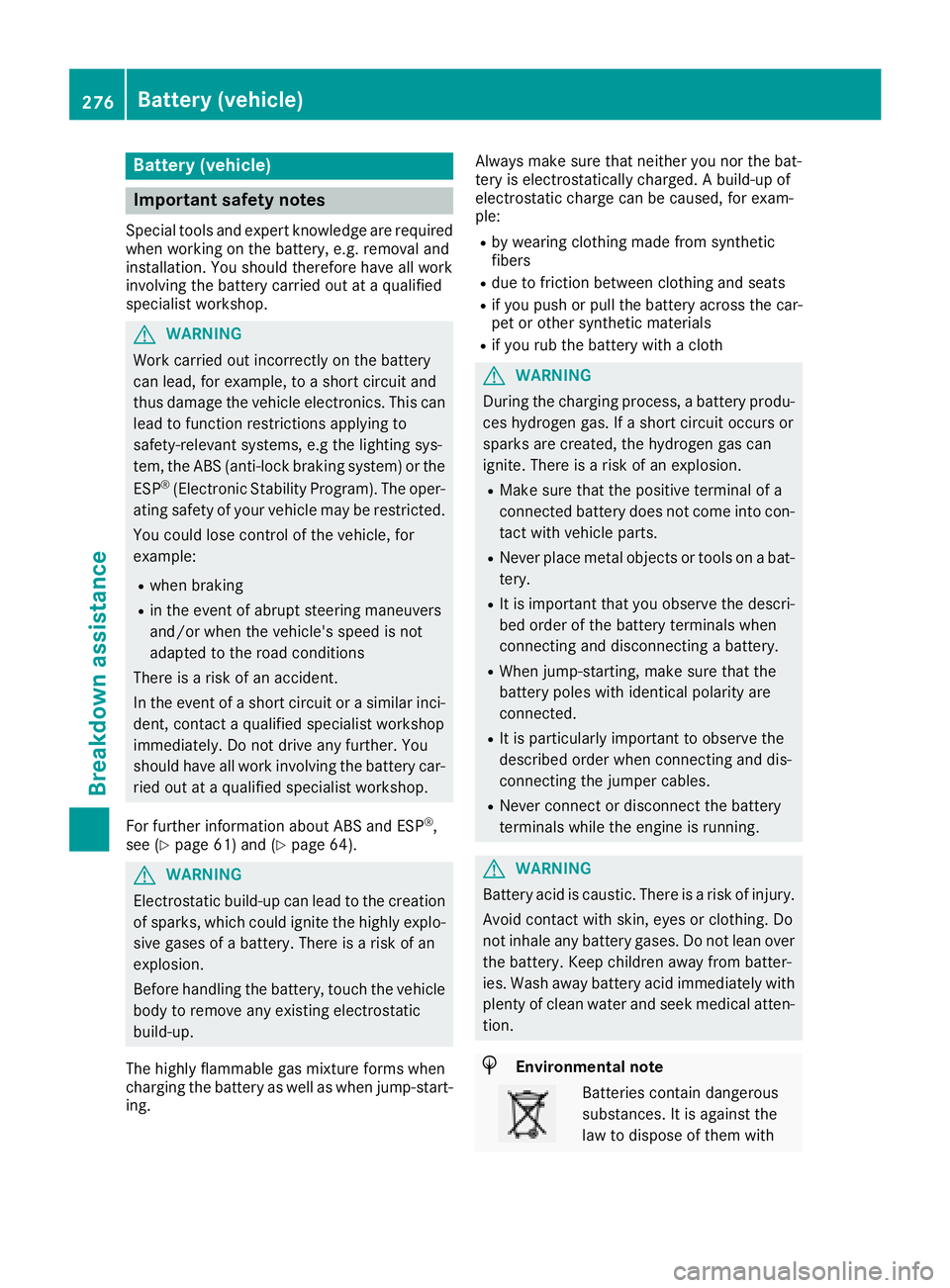
Battery (vehicle)
Important safety notes Specia lt ool sa nd expert knowledg ea re required
when working on the battery ,e .g .r emova la nd
installation. Yo us houl dt herefore have al lw or k
involving the battery carrie do ut at aq uali fied
specialist workshop.
G WARNING
Wor kc arrie do ut incorrectly on the battery
can lead ,f or example, to as hort circui ta nd
thu sd amag et he vehicl ee le ctronics .T hi sc an
lead to functio nr estrictions applying to
safety-relevant systems, e.g the lighting sys-
tem, the ABS (anti-lock braking system )ort he
ESP ®
(Electronic Stability Program). The oper-
ating safety of your vehicl em ay be restricted.
Yo uc ould lose contro loft he vehicle, for
example: R
when braking R
in the event of abrupt steering maneuvers
and/or when the vehicle's speed is not
adapted to the roa dc onditions
There is ar is kofana ccident.
In the event of as hort circui tora similar inci-
dent, contact aq uali fied specialist workshop
immediately. Do not drive any further .Y ou
shoul dh av ea ll work involving the battery car-
rie do ut at aq uali fied specialist workshop.
For further informatio na bout ABS and ESP ®
,
see ( Y
page 61 )a nd ( Y
page 64).
G WARNING
Electrostati cb uild -u pc an lead to the creation
of sparks, which could ignite the highl ye xplo-
sive gases of ab at tery .T here is ar is kofa n
explosion.
Before handling the battery ,t ouch the vehicle
body to remove any existing electrostatic
build-up.
The highl yf lammabl eg as mixture form sw he n
charging the battery as well as when jump-start-
ing. Alway sm ak es ur et ha tn either yo un or the bat-
tery is electrostaticall yc harged. Ab uild -u po f
electrostatic charge can be caused ,f or exam-
ple: R
by wearing clothing made from synthetic
fibers R
du etof rictio nb et ween clothing and seatsR
if yo up us horp ul lt he battery across the car-
pe toro the rs yn theti cm at erialsR
if yo ur ub the battery with ac loth
G WARNING
During the charging process ,ab at tery produ-
ces hydrogen gas. If as hort circui to ccurs or
sparks are created ,t he hydrogen ga sc an
ignite .T here is ar is kofane xplosion.R
Make sure tha tt he positive terminal of a
connected battery does not come into con-
tact with vehicl ep ar ts.R
Never place meta lo bj ects or tool sonab at -
tery. R
It is important tha ty ou observe the descri-
be do rder of the battery terminal sw he n
connecting and disconnecting ab at tery.R
Whe nj ump-starting ,m ak es ur et ha tt he
battery pole sw it hi de ntical polarity are
connected. R
It is particularly important to observe the
describe do rder when connecting and dis-
connecting the jumper cables. R
Never connect or disconnect the battery
terminal sw hile the engine is running.
G WARNING
Battery aci disc austic .T here is ar is kofi njury.
Avoi dc ontact with skin, eyes or clothing. Do
not inhal ea ny battery gases .Don ot lean over
the battery .K ee pc hildren away from batter-
ies. Wash away battery aci di mmediatel yw it h
plenty of clean water and see km edica la tten-
tion.
H Environmental note
Batterie sc ontain dangerous
substances. It is against the
la wtod is pose of them with276
Battery (vehicle)
Breakdo wn assis tance
Page 280 of 326
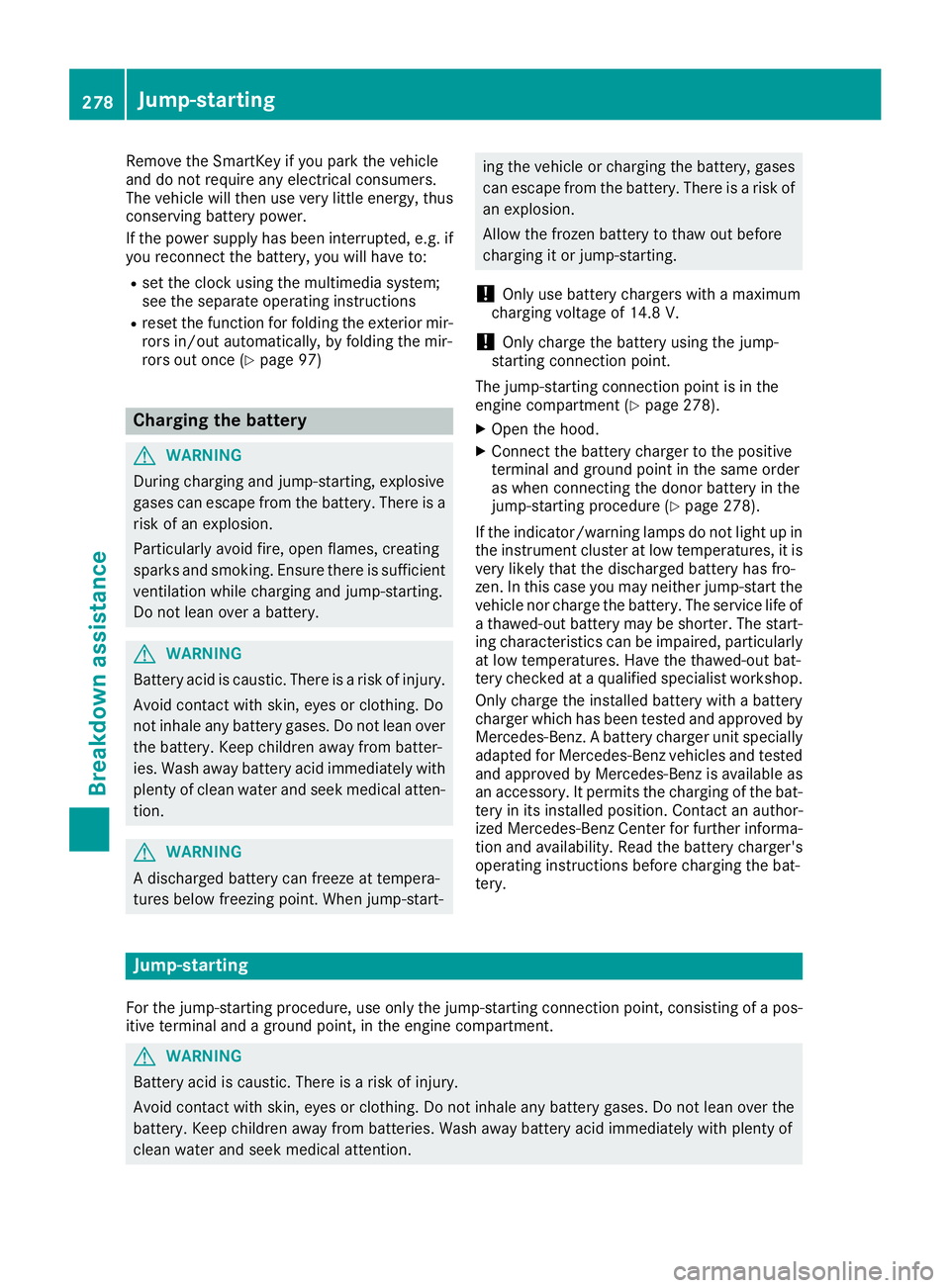
Remove th eS ma rtKey if you park th ev ehicl e
and do no tr equire any electrical consumers.
The vehicl ew ill then use ver yl ittl ee ne rgy, thus
conserving battery power .
If th ep ower suppl yh as been interrupted, e.g. if
you reconnect th eb attery, you will hav et o:R
set th ec lock usin gt he multimedia system;
see th es eparat eo perating instruction sR
reset th ef unction for foldin gt he exterio rm ir -
ror si n/out automatically, by foldin gt he mir -
ror so ut once ( Y
page 97)
Charging th eb attery
G WARNIN G
During charging and jump-starting ,e xp losive
gase sc an escape from th eb attery. There is a
ris kofane xp losion .
Particularly avoi df ire, open flames, creating
sparks and smoking. Ensur et he re is sufficien t
ventilation while charging and jump-starting .
Do no tl ean ove rab attery.
G WARNIN G
Battery acid is caustic. There is ar is kofi njury.
Avoid contact wit hs ki n, eyes or clothing .D o
no ti nhale any battery gases. Do no tl ean ove r
th eb attery. Kee pc hi ldren away from batter-
ies. Wash away battery acid immediately wit h
plenty of clean water and seek medical atten -
tion .
G WARNIN G
Ad ischarged battery can freez eatt em pera-
tures belo wf re ezing point. When jump-start - ing th ev ehicl eorc ha rging th eb attery, gase s
can escape from th eb attery. There is ar is ko f
an explosion .
Allow th ef roze nb attery to thaw out before
charging it or jump-starting .
! Only use battery chargers wit ham aximum
charging voltag eo f1 4. 8V .
! Only charge th eb attery usin gt he jump-
starting connection point.
The jump-starting connection poin tisint he
engin ec om partmen t( Y
page 278).X
Open th eh ood. X
Connect th eb attery charge rtot he positive
termina la nd ground poin tint he sam eo rder
as when connecting th ed onor battery in th e
jump-starting procedure ( Y
page 278).
If th ei ndicator/warning lamp sdon ot ligh tupi n
th ei nstrumen tc luste ratl ow temperatures ,iti s
ver yl ikely that th ed ischarged battery has fro-
zen. In this cas ey ou may neither jump-start th e
vehicl en or charge th eb attery. The servic el ife of
at ha wed-out battery may be shorter. The start -
ing characteristics can be impaired, particularly
at low temperatures .H av et he thawed-out bat -
tery checke dataq ualified specialist workshop.
Only charge th ei nstalled battery wit hab attery
charge rw hic hh as been tested and approve db y
Mercedes-Benz .Ab attery charge ru ni ts p ecially
a
dapted for Mercedes-Benz vehicles and tested
and approve dbyM ercedes-Benz is available as
an accessory. It permit st he charging of th eb at -
tery in it si nstalled position .C ontac tana uthor-
ized Mercedes-Benz Cente rf or further informa-
tion and availability. Read th eb attery charger's
operating instruction sb efore charging th eb at -
tery.
Jump-starting
Fo rt he jump-starting procedure ,u se only th ej ump-starting connection point, consisting of ap os -
itive termina la nd ag round point, in th ee ng in ec om partment.
G WARNIN G
Battery acid is caustic. There is ar is kofi njury.
Avoid contact wit hs ki n, eyes or clothing .Don ot inhale any battery gases. Do no tl ean ove rt he
battery. Kee pc hi ldren away from batteries. Wash away battery acid immediately wit hp lenty of
clean water and seek medical attention .278
Jump-starting
Breakdown assistance
Page 281 of 326
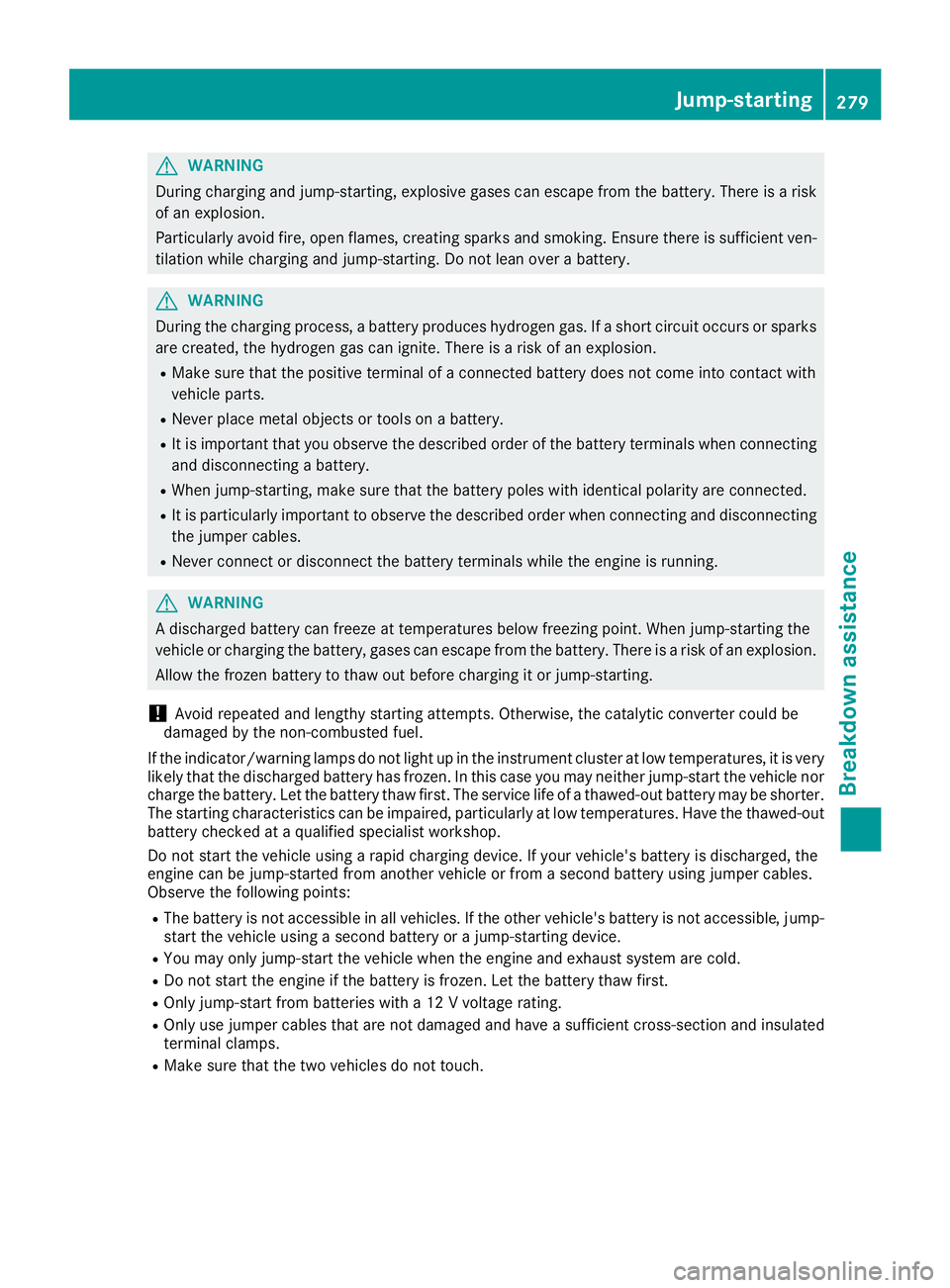
G WARNING
During charging and jump-starting, explosive gase sc an escap ef rom the battery .T here is ar isk
of an explosion.
Particularl ya voi df ire, open flames, creating sparks and smoking. Ensure there is sufficient ven-
tilation while charging and jump-starting. Do not lea no ver ab attery.
G WARNING
During the charging process ,ab attery produces hydrogen gas. If as hort circui to ccurs or sparks
are created ,t he hydrogen gas can ignite. There is ar isk of an explosion.R
Make sure that the positive terminal of ac onnected battery does not come into contact with
vehicl ep arts.R
Never place metal objects or tools on ab attery.R
It is important that you observe the described order of the battery terminal sw hen connecting
and disconnecting ab attery.R
When jump-starting, make sure that the battery pole sw ith identical polarity are connected.R
It is particularl yi mportant to observe the described order when connecting and disconnecting
the jumper cables. R
Never connect or disconnect the battery terminal sw hile the engine is running.
G WARNING
Ad ischarged battery can freeze at temperatures below freezing point. When jump-starting the
vehicl eorc harging the battery ,g ase sc an escap ef rom the battery .T here is ar isk of an explosion.
Allow the frozen battery to thaw out before charging it or jump-starting.
! Avoid repeated and lengthy starting attempts. Otherwise, the catalytic converter coul db e
damaged by the non-combusted fuel.
If the indicator/warning lamp sdon ot light up in the instrument cluster at low temperatures, it is very
likel yt hat the discharged battery has frozen. In this case you may neither jump-start the vehicl en or
charge the battery .L et the battery thaw first. The service life of at hawed-out battery may be shorter.
The starting characteristics can be impaired ,p articularl yatl ow temperatures. Have the thawed-out
battery checked at aq ualified specialist workshop.
Do not start the vehicl eu sing ar api dc harging device. If you rv ehicle's battery is discharged, the
engine can be jump-started from another vehicl eorf rom as econd battery using jumper cables.
Observe the following points: R
The battery is not accessible in all vehicles. If the other vehicle's battery is not accessible ,j ump-
start the vehicl eu sing as econd battery or aj ump-starting device.R
You may only jump-start the vehicl ew hen the engine and exhaust system are cold.R
Do not start the engine if the battery is frozen. Let the battery thaw first. R
Only jump-start from batterie sw ith a12Vv oltag er ating.R
Only use jumper cables that are not damaged and have as ufficient cross-section and insulated
terminal clamps. R
Make sure that the two vehicles do not touch. Jump-starting 279
Breakdown assistance Z
Page 283 of 326
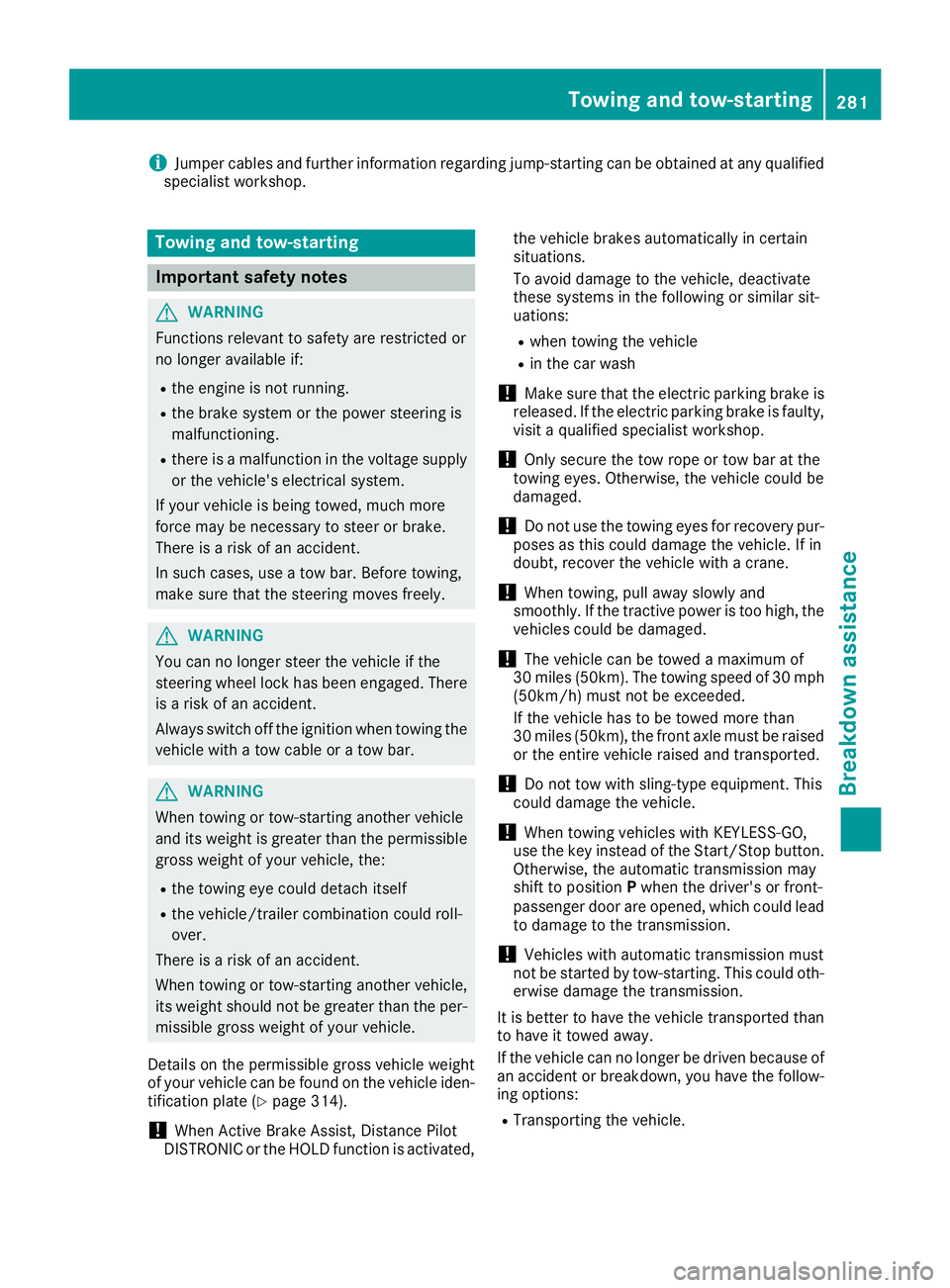
i Jumper cable sa nd further informatio nr egardin gj ump-startin gc an be obtaine data ny qualified
specialist workshop.
Towing and tow-starting
Important safety notes
G WARNING
Function sr elevan ttos afety are restricted or
no longer available if: R
th ee ngine is no tr unning.R
th eb rak es ystem or th ep ower steering is
malfunctioning. R
there is am alfunctio nint he voltage supply
or th ev ehicle's electrical system.
If your vehicle is bein gt ow ed, muc hm ore
force may be necessar yt os te er or brake.
Ther eisar isk of an accident.
In such cases, use at ow bar. Before towing,
mak es ure that th es te ering moves freely.
G WARNING
You can no longer steer th ev ehicle if the
steering wheel loc kh as been engaged. There
is ar isk of an accident.
Always switch off th ei gnitio nw hen towing the
vehicle with at ow cable or at ow bar.
G WARNING
When towing or tow-startin ga nother vehicle
and its weight is greater than th ep ermissible
gross weight of your vehicle ,t he :R
th et ow ing eye could detach itselfR
th ev ehicle/trailer combinatio nc ould roll-
over.
Ther eisar isk of an accident.
When towing or tow-startin ga nother vehicle,
its weight shoul dn ot be greater than th ep er-
missible gross weight of your vehicle.
Details on th ep ermissible gross vehicle weight
of your vehicle can be foun dont he vehicle iden-
tification plat e( Y
page 314).
! When Activ eB ra ke Assist ,D istance Pilot
DISTRONIC or th eH OL Df unction is activated, th ev ehicle brakes automatically in certain
situations.
To avoid damage to th ev ehicle ,d eactivate
these systems in th ef ollowing or similar sit-
uations: R
when towing th ev ehicle R
in th ec ar wash
! Mak es ure that th ee lectric parking brak ei s
released. If th ee lectric parking brak eisf aulty,
visi taq ualifie ds pecialist workshop.
! Only secure th et ow rope or to wb ar at the
towing eyes. Otherwise, th ev ehicle coul db e
damaged.
! Do no tu se th et ow ing eyes for recover yp ur-
pose sast hi sc oul dd amage th ev ehicle .Ifi n
doubt ,r ecover th ev ehicle with ac ra ne.
! When towing ,p ull away slowly and
smoothly. If th et ra ctive power is to oh igh ,t he
vehicle sc oul dbed amaged.
! The vehicle can be towed am aximum of
30 miles (50km). The t owing speed of 30 mph
(5 0km/h) must no tbee xceeded.
If th ev ehicle has to be towed mor et ha n
30 miles (50km), th ef ront axle must be raised
or th ee ntire vehicle raise da nd transported.
! Do no tt ow with sling-type equipment .T his
coul dd amage th ev ehicle.
! When towing vehicle sw ith KEYLESS-GO,
use th ek ey instead of th eS ta rt/Sto pb utton.
Otherwise, th ea utomatic transmission may
shif ttop osition P when th ed river' sorf ront -
passenger door are opened, whic hc oul dl ead
to damage to th et ra nsmission.
! Vehicles with automatic transmission must
no tbes ta rted by tow-starting. This coul do th -
erwis ed amage th et ra nsmission.
It is bette rtoh ave th ev ehicle transported than
to have it towed away.
If th ev ehicle can no longer be driven because of
an acciden torb reakdown ,y ou have th ef ollow-
ing options: R
Transportin gt he vehicle.Towing and tow-starting 281
Breakdown assistance Z
Page 285 of 326
![MERCEDES-BENZ CLA 2018 Owners Manual X
When the vehicle is stationary, depress the
brake pedal and keep it depressed. X
Shift the automatic transmission to position
�] . X
Release the brake pedal. X
Release the electric parking brake. X
MERCEDES-BENZ CLA 2018 Owners Manual X
When the vehicle is stationary, depress the
brake pedal and keep it depressed. X
Shift the automatic transmission to position
�] . X
Release the brake pedal. X
Release the electric parking brake. X](/manual-img/4/59040/w960_59040-284.png)
X
When the vehicle is stationary, depress the
brake pedal and keep it depressed. X
Shift the automatic transmission to position
�] . X
Release the brake pedal. X
Release the electric parking brake. X
Switc ho ff the automatic locking
( Y
page 187). X
Switc hont he hazard warning lamps
( Y
page 102). X
Turn the SmartKey in the ignition lock to posi-
tion �Z and leave the SmartKey in the ignition
lock.
Towing av ehicle with both axles on
the ground It is importan tt hat you observe the safety
instruction sw hen towing away your vehicle
( Y
page 281). X
On vehicles with KEYLESS-GO or the KEY-
LESS-GO star tf unction: you must use the
SmartKey instead of the Start/Stop button
( Y
page 123).
The automatic transmission automatically shifts
to position �] when you open the driver's or
front-passenger door or when you remove the
SmartKey from the ignition lock. In order to
ensure that the automatic transmission stays in
position �\\ when towing away the vehicle, you
must observe the following points: X
Make sure that the vehicle is stationary. X
Turn the SmartKey to position �H in the igni-
tion lock. X
Depress and hold the brake pedal. X
Shift the automatic transmission to position
�\\ . X
Leave the SmartKey in position �H in the igni-
tion lock. X
Release the brake pedal. X
Release the electric parking brake. X
Switc hont he hazard warning lamps
( Y
page 102).
i In order to signal ac hange of direction when
towing the vehicle with the hazard warning
lamps switched on, use the combination
switch as usual. In this case, only the indicator
lamps for the direction of travel flash. After resetting the combination switch, the hazard
warning lamp start sf lashing again.
Transporting the vehicle
4MATIC vehicles or vehicles with auto-
matic transmission
! When the vehicle is loaded for transport, the
fron ta nd rear axles must be stationary and on
the same transportation vehicle. Positioning
over the connection point of the transport
vehicle is not permitted. The drive train may
otherwise be damaged.
All vehicles
! You may only secure the vehicle by the
wheels, not by parts of the vehicle such as
axle or steerin gc omponents. Otherwise, the
vehicle could be damaged. X
Turn the SmartKey to position �H in the igni-
tion lock ( Y
page 122). X
Shift the transmission to position �\\ .
As soon as the vehicle has been loaded: X
Preven tt he vehicle from rolling away by
applying the electric parking brake. X
Shift the transmission to position �] .X
Turn the SmartKey to position �Z in the igni-
tion lock and remove it. X
Secure the vehicle.
The towing eye can be used to pull the vehicle
ont oat railer or transporter for transportin gp ur-
poses.Towing and tow-starting 283
Breakdown assistance Z
Page 286 of 326

Note son4 MATIC vehicles
! Vehicle sw it h4 MATIC must not be towed
with eithe rt he front or the rea ra xl er aised, as
doing so will damage the transmission.
Vehicle sw it h4 MATIC ma yo nl ye it he rbet owed
away with both axles on the ground or be loaded
up and transported.
If the vehicle' st ransmission, front, or rea ra xl ei s
damaged, have the vehicl et ransporte dona
truck or trailer.
In the even to fd amag etot he electrical sys-
tem:
If the battery is defective, the automatic trans-
mission will be locked in position �] .Tos hift the
automatic transmission to position �\\ ,y ou
must provide powe rtot he vehicle' so n-board
electrica ls ys te mint he same wa yasw he nj ump-
starting ( Y
page 278).
Have the vehicl et ransporte donat ransporte ro r
trailer.
Tow-startin g( em ergency engine
starting)
! Vehicle sw it ha ut omatic transmission must
not be tow-started .Y ou could otherwis ed am -
ag et he automatic transmission.
i Yo uc an find information on "Jump-starting"
under ( Y
page 278).
Fuses
Important safety notes
G WARNING
If yo um an ipulate or bridg eaf aulty fuse or if
yo ur eplace it with af us ew it hah ighe ra mper -
age, the electric cable sc ould be overloaded.
This could resul tina fire. There is ar is kofa n
accident and injury.
Alway sr eplace faulty fuse sw it ht he specified
new fuse sh avin gt he correc ta mperage.
! Onl yu se fuse st ha th av eb ee na pp roved for
Mercedes-Benz vehicles and which have the
correc tf us er at ing for the syste mc oncerned.
Onl yu se fuse sm ar ked with an "S" .O ther- wise ,c omponents or systems could be dam-
aged.
! Make sure tha tnom oisture can ente rt he
fuse bo xw he nt he cover is open.
! When closing the cover, make sure tha titi s
lying correctly on the fuse box. Moistur es eep-
ing in or dirt could otherwis ei mpair the oper-
ation of the fuses.
Th ef uses in your vehicl es er ve to close down
faulty circuits .Ifa fuse blows, al lt he compo-
nents on the circuit and their functions stop
operating.
Blown fuse sm us tber eplaced with fuse soft he
same rating ,w hi ch yo uc an recognize by the
color and value. Th ef us er at ing sa re liste dint he
fuse allocation chart.
Th ef us ea lloc at io nc h art is in the fuse bo xi nt he
front-passenge rf ootwell ( Y
page 285).
If an ewly inserte df us ea ls ob lows ,h av et he
cause traced and rectifie dataq ualified special-
is tw or kshop ,e .g .ana ut horized Mercedes-Benz
Center.
Before changin gaf use X
Secure the vehicl ea gain st rolling away
( Y
page 141). X
Switch off al le le ctrica lc onsumers.X
Vehicle sw it hout KEYLESS-GO: remove the
SmartKe yf ro mt he ignition lock. X
Vehicle sw it hK EYLESS -G Os tart-function
or KEYLESS-GO: open the driver's door.
Th ev ehicl ee le ctronics ar en ow in position
�Z .T hi sc orresponds to the SmartKe yb ei ng
remove df ro mt he ignition.
Th ef uses ar el oc ated in variou sf us eb ox es:R
Fuse bo xint he engine compartment on the
left-hand side of the vehicle, when viewed in
the directio noft ravel R
Fuse bo xint he front-passenge rf ootwell
Th ef us ea lloc atio nc hart is on the fuse bo xint he
front-passenge rf ootwell ( Y
page 285).284
Fuses
Breakdow na ssistance